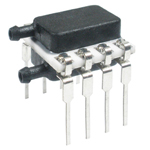HSCDRRN001NDSA5 - TruStability® HSC Series, digital SPI, DIP, RR: dual radial barbed ports, same side, differential, ±1 inH2O, 5.0 Vdc || HSCDRRN001NDSA5 - Quad Industry GmbH
Àðòèêóë: HSCDRRN001NDSA5
Íàèìåíîâàíèå: TruStability® HSC Series, digital SPI, DIP, RR: dual radial barbed ports, same side, differential, ±1 inH2O, 5.0 Vdc || HSCDRRN001NDSA5
Ïðîèçâîäèòåëü: Honeywell
|
|

| Description | | The TruStability® High Accuracy Silicon Ceramic (HSC) Series is a piezoresistive silicon pressure sensor offering a digital output for reading pressure over the specified full scale pressure span and temperature range. The HSC Series is fully calibrated and temperature compensated for sensor offset, sensitivity, temperature effects, and non-linearity using an on-board Application Specific Integrated Circuit (ASIC). Calibrated output values for pressure are updated at approximately 2 kHz. The HSC Series is calibrated over the temperature range of 0 °C to 50 °C [32 °F to 122 °F]. The sensor is characterized for operation from a single power supply of either 3.3 Vdc or 5.0 Vdc. These sensors measure differential and gage pressures. Differential versions allow application of pressure to either side of the sensing diaphragm. Gage versions are referenced to atmospheric pressure and provide an output proportional to pressure variations from atmosphere. The HSC Series sensors are intended for use with non-corrosive, non-ionic working fluids. They are designed and manufactured according to standards in ISO 9001. | | Features | - Proprietary Honeywell technology: Combines high sensitivity with high overpressure and burst pressure—two performance factors that are difficult to achieve in the same product, this gives the customer more flexibility in sensor implementation and reduces the customer design requirements for protecting the sensor without sacrificing the ability to sense very small changes in pressure
- Industry-leading long-term stability: Even after long-term use and thermal extremes, these sensors perform substantially better relative to stability than any other pressure sensor available in the industry today:
- Minimizes system calibration needs
- Maximizes system performance
- Helps support system uptime by eliminating the need to service or replace the sensor during its application life
- Industry-leading Total Error Band (TEB): Honeywell specifies TEB—the most comprehensive, clear, and meaningful measurement—that provides the sensor’s true accuracy over a compensated range of 0 °C to 50 °C [32 °F to 122 °F]:
- Eliminates individually testing and calibrating every sensor, which can increase their manufacturing time and process
- Supports system accuracy and warranty requirements
- Helps to optimize system uptime
- Provides excellent sensor interchangeability—there is minimal part-to-part variation in accuracy
- Industry-leading accuracy: Extremely tight accuracy of ±0.25 %FSS BFSL (Full Scale Span Best Fit Straight Line):
- Reduces software needs to correct system inaccuracies, minimizing system design time
- Supports system accuracy and warranty requirements
- Helps to optimize system uptime
- High burst pressures above 415 inH2O (1034 mbar):
- Allows the sensor to endure a wide range of conditions while maintaining a high level of sensitivity which measures even the smallest change in pressure
- Can simplify the design process
- High working pressure ranges above 135 iinH2O (336 mbar): Allows ultra-low pressure sensors to be used continuously well above the calibrated pressure range
- Industry-leading flexibility
- Modular, flexible design with many package styles (with the same industry-leading stability), pressure ports, and options simplify integration into the device manufacturer’s application
- Available soon: single side liquid media option allows the end customer to use one port of the sensor with condensing humidity or directly with non-corrosive liquid media
- Repeatability: Provides excellent repeatability, high accuracy and reliability under many demanding conditions
- Onboard signal conditioning: Typically allows for the removal of signal conditioning components from the PCB, reducing costs and simplifying production processes
- Wide variety of pressure ranges: From ±2.5 mbar to ±40 mbar [±1 inH2O to ±30 inH2O] provide support for many unique applications
- Meets IPC/JEDEC J-STD-020D.1 Moisture Sensitivity Level 1 requirements:
- Allows the customer to avoid the thermal and mechanical damage during solder reflow attachment and/or repair that lesser rated products would incur
- Allows unlimited floor life when stored as specified (<30 ?C/85 %RH), simplifying storage and reducing scrap
- Insensitive to mounting orientation:
- Allows customers to position the sensor in the most optimal point in the system, eliminating the concern for positional effects
- Increases flexibility of use within the application
- Insensitive to vibration: Reduces susceptibility to application-specific vibration that occurs with changes in pressure, minimizing inaccurate pressure readings
- Custom calibration: Typically allows for the removal of additional components associated with signal conditioning from the PCB, reducing PCB size as well as costs often associated with those components (e.g., acquisition, inventory, assembly)
- Internal diagnostic functions: Increases system reliability
- Energy efficient: Extremely low power consumption (less than 10 mW, typ.):
- Reduces power consumption
- Provides extended battery life
- Promotes energy efficiency
Output: I2C- or SPI-compatible 14-bit digital output (min. 12-bit sensor resolution) accelerates performance through reduced conversion requirements and the convenience of direct interface to microprocessors or microcontrollers, analog output also available - Small size: Miniature 10 mm x 10 mm [0.39 in x 0.39 in] package is very small when compared to most board mount pressure sensors:
- Occupies less area on the PCB
- Typically allows for easy placement on crowded PCBs or in small devices
- RoHS compliant
- Protected by multiple global patents
|
| | Potential Applications | Medical: - Ventilators
- Anesthesia machines
- Spirometers
- Nebulizers
- Hospital room air pressure
Industrial: - VAV (Variable Air Volume) control
- Static duct pressure
- Clogged HVAC (Heating, Ventilation, and Air Conditioning) filter detection
- HVAC transmitters
- Indoor air quality
|
| | Product Specifications | | Measurement Type | Differential | | Signal Conditioning | Amplified | | Pressure Range | ±1 inH2O | | Overpressure | 270 inH2O | | Supply Voltage | 5.0 Vdc, typ. | | Supply Current | 2 mA | | Temperature Compensation | Yes | | Output Calibration | Yes | | Response Time | 0.46 ms typ. | | Port Style | RR: dual radial barbed ports, same side | | Package Type | DIP | | Total Error Band (% Full Scale) | ±3 %FSS | | Accuracy (Best Fit Straight Line) | ±0.25% | | Output | Digital SPI | | Transfer Function | 10% to 90% of 214 counts | | Shock | MIL-STD-202F, Method 213B, Condition F | | Vibration | MIL-STD-202F, Curve AK (20.7 g random) | | Operating Temperature | -20 °C to 85 °C [-4 °F to 185 °F] | | Compensated Temperature Range | 0 °C to 50 °C [32 °F to 122 °F] | | UNSPSC Code | 41111927 | | UNSPSC Commodity | 41111927 Pressure Sensors | | Availability | Global | | Series Name | TruStability® HSC |
|
Íàçàä â ðàçäåë
|














